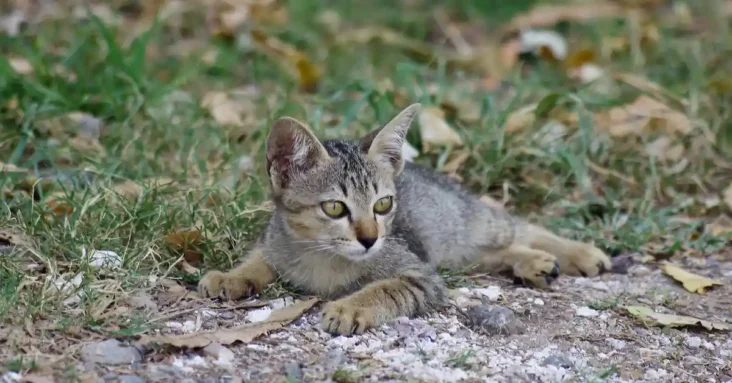Have you ever heard someone refer to a cat as a “tom” and wondered what breed that is? Maybe you’ve seen a big, scrappy-looking cat wandering around your neighborhood and someone said, “Oh, that’s just a tomcat.” But here’s the thing: Tomcat isn’t a breed.
So, what is a tomcat exactly? Why do people use that word? And what makes them stand out from other cats?
Let’s talk about tomcats in a way that makes sense, especially if you’re confused or just curious.
What Is a Tomcat?
A tomcat is simply an un-neutered male cat. That’s it. Nothing more, nothing less. The term doesn’t describe a breed, color, or personality type—it just refers to the gender and reproductive status of the cat.
If you’ve ever watched stray or outdoor cats, the big, muscular ones with scarred ears and an uncompromising attitude are often tomcats. They’re known for wandering around searching for mates, getting into fights, and marking their territory. But they can be just as loving and gentle, especially once neutered.
Fun Fact:
The term “tomcat” became popular after the 1760s when a book titled “The Life and Adventures of a Cat” introduced a character named Tom. The name stuck.
Do Tomcats Have a Unique Look?
While tomcats aren’t a specific breed, they often share some physical traits, mainly because of hormones. Unneutered males tend to have:
- Broader faces
- Thicker necks
- Larger, more muscular bodies
- A rougher or more rugged appearance
These traits develop due to testosterone. These features are usually less pronounced once a male cat is neutered, especially at a young age.
You might notice some tomcats look a bit battle-worn. That’s not just a stereotype—it’s often true. Outdoor toms get into territorial fights with other males so that you might see scratches, notches in ears, or torn fur.
What Are Tomcats Like in Terms of Behavior?
Tomcats can be a handful, depending on whether they’re neutered.
Unneutered Tomcats:
- Roam far from home (sometimes miles away!)
- Spray strong-smelling urine to mark territory
- Try to mate with as many females as possible
- Can be aggressive toward other males
- Often vocal and restless
Neutered Male Cats:
- Tend to be calmer and more affectionate
- Don’t spray or roam as much
- They are usually great with people and other pets
- Still playful, but more focused on their human family
If you’ve adopted and neutered a male cat, you won’t deal with the typical “tomcat” behaviors for long. Within a few weeks, most of the hormone-driven habits fade away.
Are Certain Breeds More Likely to Act Like Tomcats?
No breed creates a tomcat—it’s all about hormones, not genetics. Some male cats from naturally active or territorial breeds (like Bengals or Siamese) might still act bold or adventurous, especially if they’re unneutered.
But any male cat—a Persian or a tabby mix—can be a tomcat if he hasn’t been fixed. So you might see a Maine Coon tom, a Siamese tom, or just a regular domestic shorthair tom wandering around.
Why Do People Get Confused About Tomcats Being a Breed?
It’s a common mistake. The word “tomcat” sounds like a name, kind of like “Siamese” or “Persian.” And when people see certain toms with big muscles and a rough coat, they think it must be a distinct breed.
It’s especially easy to mix things up if you’re unfamiliar with cat terminology. If someone says, “He’s a tomcat,” it can sound like they’re talking about a rare or unique type of feline. But really, they just mean he’s an adult, intact male.
It’s also worth noting that cartoon characters like Tom from Tom and Jerry helped cement the word “Tom” as something associated with a specific type of male cat. But again, it’s a gender label, not a breed name.
Do Tomcats Make Good Pets?
Absolutely. Whether a male cat is neutered, he can make an excellent companion. However, neutering makes a big difference in behavior.
Neutered tomcats are often:
- Super affectionate
- Lap-lovers
- Loyal to their people
- Good with other pets (if introduced properly)
Unlike unneutered males, they don’t have that aggressive edge or constant need to escape the house. Once neutered, their personalities often blossom in the sweetest ways.
I remember adopting my cat, Max, from a local shelter. He was a tomcat when they found him—skinny, scarred, and terrified. But once he was neutered and felt safe, he became the gentlest soul. He curls up by my feet every night, and you’d never guess he once roamed the streets like a tough guy.
Should You Neuter a Tomcat?
If you’re not planning to breed your cat responsibly, yes—neutering is a wise, loving choice. It helps reduce overpopulation, protects your cat’s health, and prevents unwanted behaviors.
Benefits of Neutering:
- Stops spraying and marking
- Reduces aggression and fighting
- Prevents testicular cancer
- Lowers the risk of roaming and getting lost
- Makes life indoors more peaceful—for you and your cat
Most vets recommend neutering male kittens around 4–6 months old. But even adult tomcats can be neutered with excellent results.
Are There Famous or Popular “Tomcats”?
Aside from Tom from Tom and Jerry, the world of fiction and pop culture is full of bold male cats that fit the tomcat vibe.
Characters like:
- Garfield (lazy but sassy)
- Top cat (street-smart and smooth)
- Cat from Red Dwarf (vain and confident)
They all have that same independent, sometimes cocky charm we often associate with tomcats. But like in real life, their behavior varies because each tomcat has its own story.
A Tom by Any Other Name…
Whether adopting a stray male or raising a kitten, knowing what a tomcat is helps you make better decisions. It’s not about the breed, color, or attitude—it’s just biology. And once neutered, a tomcat becomes like any other cat: full of quirks, affection, and personality.
If you’re considering bringing one home, don’t let the word “tom” scare you off. With care, love, and a little patience, he might become the best friend you didn’t know you needed.







GIPHY App Key not set. Please check settings